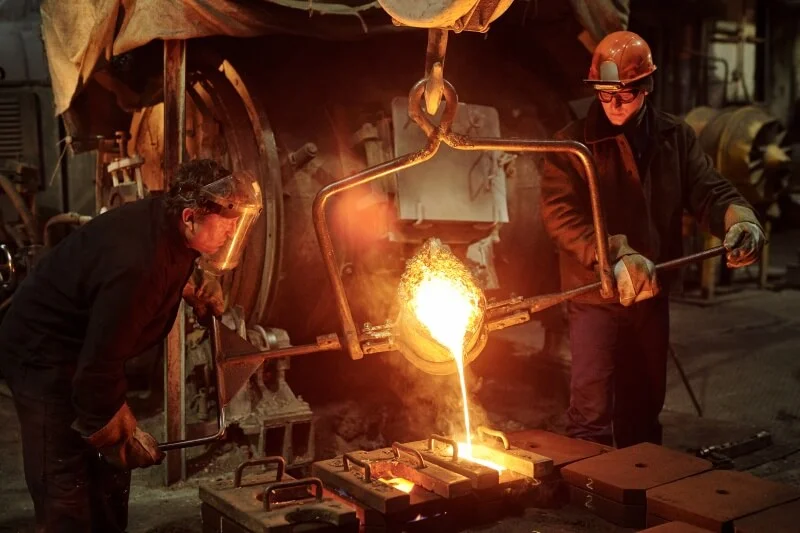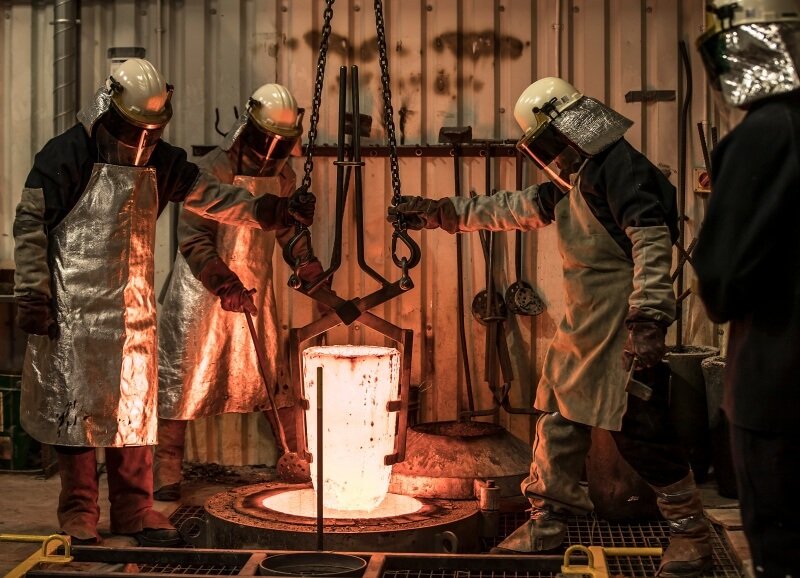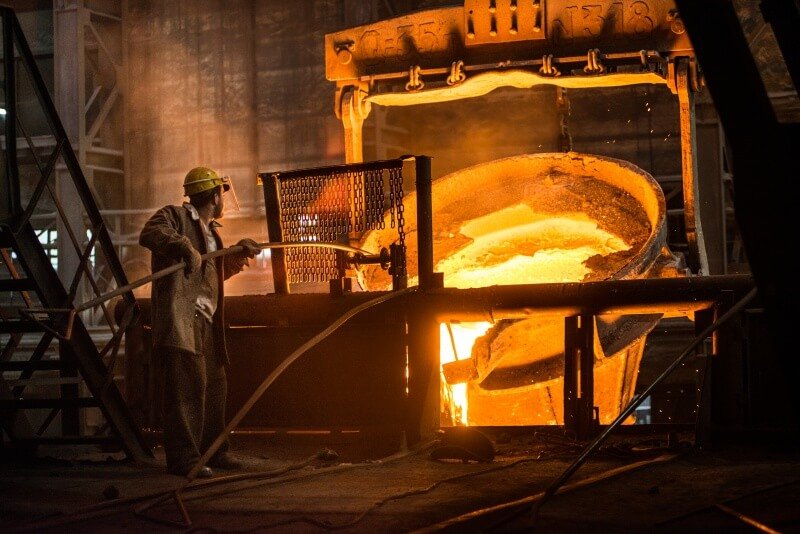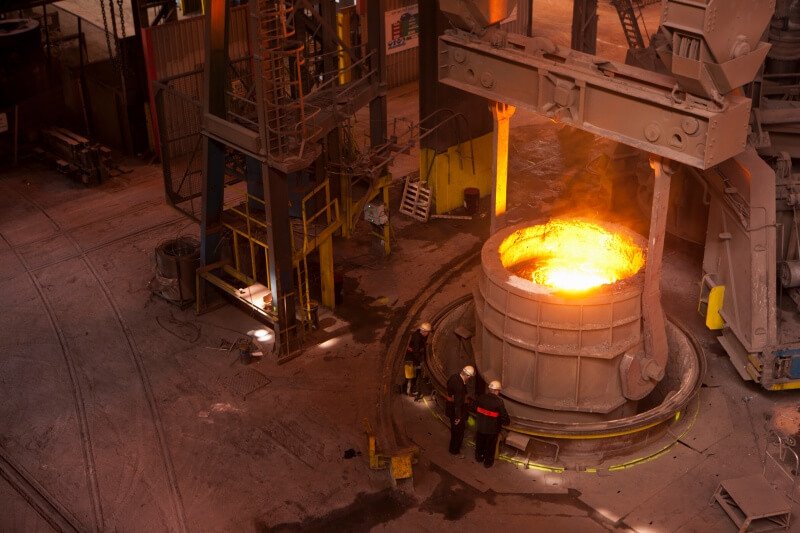Manufacturers face constant challenges in sourcing materials that achieve the ideal balance of strength, weight, and corrosion resistance. Falling short in these areas can drive up long-term costs, cause premature part failures under heavy stress, and damage brand reputation. Alloy casting provides a practical solution by enabling the creation of tailored components that are stronger, lighter, and more durable. Through the precision of alloy casting, industries gain access to customized materials that meet demanding performance requirements without compromise.
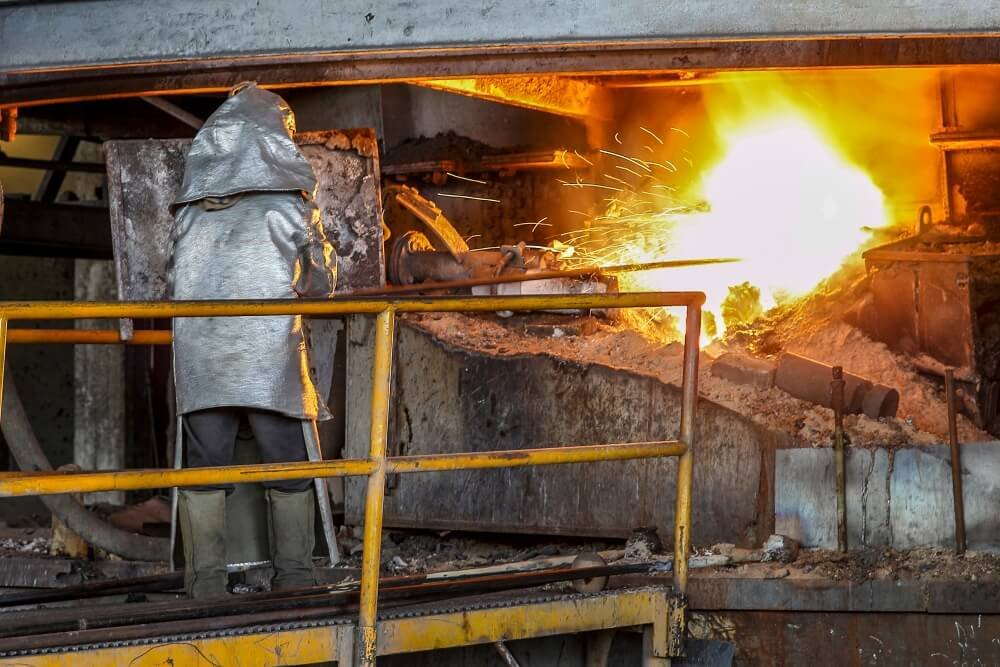
What is alloy casting?
Alloy casting is a manufacturing process where a combination of different metals and other substances is melted down and poured into a mold to create a new part. This technique allows for the creation of components with specific, enhanced properties that a single metal cannot provide. Countless industries rely on the versatile products made from this important method.
Defining the casting process
You might be wondering how it works. The process involves melting the chosen alloys and then following traditional casting procedures to form the final shape. Once poured into a mold and solidified, the component emerges with a unique combination of characteristics.
Why is it a popular choice?
This method is a popular choice for manufacturers because it offers unparalleled versatility and performance enhancements. It allows for the creation of parts that are precisely engineered for their intended function. Key reasons include:
- Ability to create custom material properties.
- Production of complex and intricate shapes.
- Improved strength-to-weight ratios.
| Step | Description | Purpose |
|---|---|---|
| 1. Melting | A blend of metals and elements is heated until liquid. | To create the molten alloy with desired properties. |
| 2. Pouring | The liquid alloy is poured into a pre-shaped mold. | To form the basic shape of the component. |
| 3. Solidifying | The alloy cools and hardens within the mold. | To create a solid, durable part. |
This systematic process ensures that the final component meets precise engineering specifications. Key Takeaway: Alloy casting is the method of melting combined metals to create custom parts in a mold, offering superior properties compared to single-metal casting.
Key features of alloy casting
The unique features of alloy casting make it a preferred choice for creating high-performance components across various sectors. These properties are not inherent to a single metal but are engineered by combining different elements. The resulting castings are superior in many functional aspects.
How are fluidity & machinability key?
Here’s the deal: when melted, alloys flow exceptionally well, making the casting process both easier and faster. This high fluidity ensures the mold fills completely, even for complex designs. Its excellent machinability means that post-casting modifications are straightforward.
Achieving superior corrosion resistance
You can easily create a corrosion-resistant alloy casting by combining a rust-proof metal with the right substances. This process allows you to engineer components that can withstand harsh environments without degrading. The choice of materials directly determines the level of protection.
Enhancing component strength
By combining a high-strength base metal with other substances, you can produce castings that are significantly stronger and more durable. The final strength is dictated by the precise combination of metals used in the alloy. This allows for:
- Increased load-bearing capacity.
- Improved resistance to wear and tear.
- Longer component lifespan.
| Feature | Description | Benefit |
|---|---|---|
| Fluidity | The ability of the molten alloy to flow easily. | Simplifies casting complex shapes and speeds up production. |
| Machinability | The ease with which a solidified part can be shaped or finished. | Reduces post-processing time and costs. |
| Corrosion Resistance | The ability to resist degradation from environmental factors. | Extends product life in harsh conditions. |
| Strength | The capacity to withstand stress and heavy loads. | Creates durable and reliable components. |
These engineered features allow for the creation of highly specialized and reliable parts. Key Takeaway: The primary features of alloy casting—fluidity, machinability, corrosion resistance, and strength—are determined by the specific combination of metals, enabling the creation of custom, high-performance parts.
Exploring zinc alloy casting
Zinc alloy casting is renowned for its specific set of properties that make it ideal for certain applications. Its low melting point and flexibility are particularly advantageous for creating detailed and intricate components. This type of casting is widely used in industries requiring precision parts.
Properties of zinc alloys
Zinc alloys are characterized by their low melting points, which simplifies the casting process and reduces energy costs. They also offer high flexibility and are very easy to machine, allowing for precise finishing. But what’s the catch? Their strength is not suitable for high-temperature or high-compression environments.
What are its common products?
Due to its unique properties, zinc alloy casting is used to manufacture a variety of everyday items and specialized equipment. The ease of casting fine details makes it a go-to choice for consumer goods and electronics. Common products include:
- Jewelry and decorative hardware.
- Electrical equipment components.
- Batteries and small mechanical parts.
Where is zinc alloy casting used?
This casting method finds its place in several major industries where precision and finish are more critical than high-temperature strength. Its versatility allows it to be used in a wide range of environments. These applications span across multiple sectors.
| Common Products | Common Applications |
|---|---|
| Jewelry, Electrical Equipment, Batteries | Automotive Industry |
| Decorative Hardware, Small Gears | Medical Sector |
| Zippers, Toy Parts | Construction & Marine Hardware |
The adaptability of zinc alloys makes them a cost-effective solution for many manufacturing needs. Key Takeaway: Zinc alloy casting is ideal for creating detailed, flexible components with excellent machinability, primarily used in the automotive, medical, and construction industries for non-high-temperature applications.
Tin and copper alloy casting
Both tin and copper alloys have been used for centuries, offering distinct advantages in strength, workability, and appearance. Tin alloy casting is often used for its durability and coating properties, while copper alloy casting is prized for its acoustic and thermal conductivity. These metals serve specialized but important industrial roles.
The role of tin alloys
Think about it this way: tin alloys are strong, durable, and highly resistant to corrosion, often used as protective coatings on other metals. They also possess low melting points, which makes them easy to work with in various applications. Common uses include:
- Tin Cans and Tin-Coated Steel
- Superconducting Magnets
- Organ pipes and bearing materials
Understanding copper alloys
Copper alloys are sturdy and workable, with good machinability, making them suitable for intricate parts. However, they can struggle to maintain their strength at very high temperatures. Their unique properties lend them to specific, high-value applications.
| Feature | Tin Alloys | Copper Alloys |
|---|---|---|
| Primary Property | Strong, Durable, Corrosion-Resistant | Sturdy, Workable, Good Machinability |
| Common Products | Tin Cans, Superconducting Magnets | Bells, Trumpets, Radiator Cores |
| Common Applications | Coatings, Bearing Materials, Organ Pipes | Musical Instruments, Technical Instruments |
These two alloy types offer specialized solutions for different industrial requirements. Key Takeaway: Tin alloy casting is excellent for durable coatings and bearings, while copper alloy casting excels in creating workable, sturdy parts like musical instruments and technical fittings.
The power of aluminum alloy casting
Aluminum alloy casting is one of the most popular and versatile methods used in modern manufacturing today. Its superior strength-to-weight ratio, combined with excellent fluidity and machinability, makes it an ideal choice for numerous industries. This process is known for accelerating production timelines significantly.
Why choose aluminum alloys?
What’s the real story? Aluminum alloys offer better strength compared to many other non-ferrous alloys while remaining lightweight. Their exceptional fluidity and machinability help speed up the entire manufacturing process. This efficiency makes them a cost-effective solution for large-scale production.
Typical aluminum alloy products
The versatility of aluminum alloy casting allows it to be used for a wide range of products, from household items to critical industrial components. Its lightweight and corrosion-resistant nature is a key advantage. Some typical products include:
- Food packaging trays and can lids.
- Automotive engine parts and frames.
- Aerospace structural components.
What are its key applications?
Aluminum alloy casting is essential in industries where weight, strength, and durability are critical factors. Its applications are vast, spanning from transportation to consumer electronics. This highlights its adaptability and widespread adoption.
| Key Advantage | Corresponding Industry Application |
|---|---|
| High Strength-to-Weight | Automotive & Aerospace (structural parts, frames) |
| Manufacturing Speed | Consumer Goods (kitchen tools, electronics) |
| Corrosion Resistance | Marine (equipment and machines) |
Aluminum’s balance of properties makes it a cornerstone of modern manufacturing. Key Takeaway: Aluminum alloy casting is a powerful method for producing strong, lightweight, and corrosion-resistant components quickly, making it essential for the automotive, aerospace, and marine industries.
Understanding lead alloy casting
Lead alloy casting is primarily known for one standout feature: its exceptional resistance to corrosion. While its overall performance in terms of strength may be inferior to other alloy types, it remains a critical material for specific industrial applications. Its density and malleability are also key characteristics.
What defines lead alloys?
Lead alloys are defined by their superior ability to resist corrosion, especially from acids. But here’s something you should know: while they excel in this area, their mechanical strength and performance at high temperatures are limited compared to other alloys. Nonetheless, they are indispensable for certain products.
Common products from lead alloys
The unique properties of lead make it the ideal material for products that require high density and corrosion resistance above all else. These products are often used in demanding environments where other metals would quickly degrade. Common examples include:
- Automotive batteries (plates and terminals).
- Radiation shielding materials.
- Cans and automobile gasoline tanks.
Main industry applications
The primary applications for lead alloy casting are concentrated in industries that can leverage its unique combination of density and chemical stability. It plays a vital role in energy storage, construction, and chemical processing. Its use is highly specialized.
| Lead Alloy Product | Primary Industry Use |
|---|---|
| Automotive Batteries | Automotive Industry |
| Sheet Lead & Pipes | Roofing & Packaging |
| Corrosion-Resistant Linings | Chemical Industry |
Lead alloys fill a crucial niche where corrosion resistance is the paramount requirement. Key Takeaway: Lead alloy casting is the go-to choice for applications requiring supreme corrosion resistance and high density, such as in automotive batteries and the chemical industry, despite its lower mechanical strength.
Metals used in alloy casting
The foundation of alloy casting is the careful selection of base metals and combining them with other substances to achieve desired properties. The choice of metal—whether ferrous or non-ferrous—directly dictates the final characteristics of the cast component. Understanding these base materials is key to successful alloy casting.
Ferrous vs. non-ferrous metals
Let’s break it down. Metals are broadly categorized as ferrous (containing iron) or non-ferrous (lacking iron). Each type imparts different qualities to an alloy, such as strength, corrosion resistance, or weldability. Common metals used include:
- Aluminum (Non-ferrous)
- Carbon Steel (Ferrous)
- Nickel (Non-ferrous)
- Cobalt (Non-ferrous)
- Stainless Steel (Ferrous)
What properties do they add?
Each metal contributes a unique set of properties to the final alloy casting. Aluminum offers machinability, while carbon steel provides strength and durability. Nickel adds high oxidation resistance, and stainless steel delivers a combination of strength and corrosion proofing.
| Metal | Key Properties Imparted to the Alloy |
|---|---|
| Aluminum | Corrosion Resistance, Machinability, Weldability |
| Carbon Steel | High Strength, Durability (low corrosion resistance) |
| Nickel | High Oxidation Resistance, Machinability, Weldability |
| Cobalt | Good Corrosion Resistance, Wear Resistance |
| Stainless Steel | High Strength, Corrosion-Resistant, Oxidation-Proof |
Selecting the right base metal is the first step toward engineering the perfect alloy. Key Takeaway: The properties of an alloy casting are determined by its base metal; aluminum adds machinability, carbon steel adds strength, and metals like nickel and stainless steel provide superior resistance to corrosion and oxidation.
The benefits of alloy casting
Alloy casting provides an efficient and effective way to create custom components tailored to specific industrial needs. This process offers significant advantages over using pure metals, including enhanced performance, greater design freedom, and improved durability. These benefits make it a cornerstone of modern manufacturing.
Why is it so efficient?
The bottom line is this: alloy casting is highly efficient due to the excellent fluidity and machinability of most alloys. These properties allow for the rapid production of complex shapes with high precision, reducing the need for extensive post-processing. This streamlines the entire manufacturing workflow from start to finish.
How it serves modern industries
Alloy casting is indispensable for creating the essential components that keep modern industries moving forward. It allows for parts that are not only strong but also perfectly suited to their operational environment. The core benefits include:
- Customization: Properties can be tailored for specific needs.
- Performance: Enhanced strength, durability, and resistance.
- Durability: Longer-lasting parts reduce replacement costs.
| Industry | Specific Benefits Gained from Alloy Casting |
|---|---|
| Automotive | Lightweight yet strong components for fuel efficiency. |
| Marine | Superior corrosion resistance for saltwater environments. |
| Medical | Biocompatible and highly precise implantable devices. |
This adaptability makes alloy casting a value-adding process across diverse sectors. Key Takeaway: Alloy casting is a highly efficient process that benefits modern industries by enabling the creation of customized, high-performance, and durable components tailored to specific applications like automotive and marine.
Diverse applications of alloy casting
The applications of alloy casting are incredibly broad, touching nearly every major industry from transportation to healthcare. Its ability to produce custom-designed components with specific properties makes it an invaluable manufacturing process. This versatility is why it’s so widely adopted.
From automotive to aerospace
This is where it gets interesting. Alloy casting is used to create everything from engine components in cars to structural parts in airplanes. In each case, the alloy is chosen to meet specific demands like weight reduction, high-temperature tolerance, or corrosion resistance. Other applications include:
- Fluid power components like pumps and valves.
- Marine hardware exposed to harsh saltwater.
- Medical implants requiring biocompatibility.
How to choose the right alloy
Choosing the right alloy is critical and depends entirely on the required properties of the final product. You must consider factors like the operating environment, load requirements, and desired lifespan of the component. Consulting with casting experts is the best way to ensure you select the optimal material for your project.
| Required Property | Recommended Alloy Type (Example) |
|---|---|
| High Strength & Low Weight | Aluminum Alloy |
| Extreme Corrosion Resistance | Stainless Steel or Lead Alloy |
| Low Cost & High Detail | Zinc Alloy |
| High Wear Resistance | Cobalt Alloy |
This matrix helps guide the selection process for specific engineering needs. Key Takeaway: The applications of alloy casting are vast, and choosing the right alloy—such as aluminum for lightweight strength or stainless steel for corrosion resistance—is critical for project success.
Conclusion: Your Partner in Precision Casting
Alloy casting effectively overcomes the limitations of single-metal parts by delivering targeted strength, durability, and performance precisely where you need it. Don’t let material compromises hold your project back. Contact the experts at Precisionvast Casting today for a consultation and find the perfect alloy casting solution for your needs. At Precisionvast Casting, we are dedicated to pushing the boundaries of manufacturing by providing innovative, reliable, and precisely engineered casting solutions that drive industries forward.
FAQ
Q1: Can I use alloy casting for parts exposed to saltwater? Absolutely. For saltwater exposure, an alloy casting made with stainless steel, aluminum, or certain copper alloys would be an excellent choice due to their superior corrosion resistance.
Q2: What’s the best alloy for a lightweight yet strong component? Aluminum alloys are generally the best choice for applications requiring a material that is both lightweight and strong, which is why they are widely used in the aerospace and automotive industries.
Q3: Is aluminum alloy casting always better than steel casting? Not necessarily. It depends on the application; while aluminum is lighter and more corrosion-resistant, steel casting offers superior strength, hardness, and durability for heavy-duty applications.
Q4: How do I choose the right type of alloy casting for my project? The right choice depends on your specific needs, such as required strength, weight, operating temperature, and corrosion resistance. Consulting with a casting specialist is the best way to determine the optimal alloy for your project.
Q5: What makes one alloy casting more corrosion-resistant than another? The level of corrosion resistance is determined by the alloy’s chemical composition. Metals like chromium (in stainless steel), aluminum, and nickel form a passive, protective oxide layer on the surface that prevents rust and degradation.

